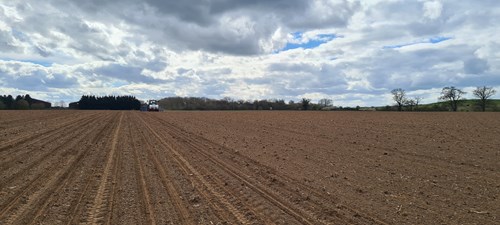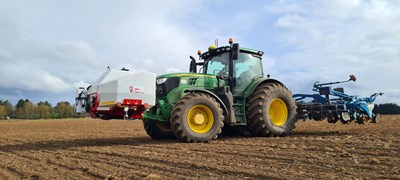Calculations from a report commissioned by British Sugar and undertaken by ADAS shows that fertilisers are the second biggest source of GHG emission on farm at 17%, after machinery which accounts for 24%. The emissions from fertiliser are high because of the fossil fuels burnt to drive the energy intensive process required in their manufacture and from nitrous oxide (N2O) emissions when fertiliser breaks down in the field. N2O is 298 times more potent than CO2 so even a small amount has a significant impact on the total GHG emissions from the sugar beet crop. This is an issue that affects all sugar beet growers, and therefore has relevance to the whole beet growing area.
Clearly there is a need to reduce GHG emissions to reach the industry target for Net Zero in 2040 as well as the increasing pressures from British Sugar customers to show the industry is making advances on reducing GHG emissions. Placing or banding fertiliser has been shown to increase N uptake and reduce overall N application (Wu et al., 2020). This is an instant win for the industry as it results in reduced GHG emissions from the sugar beet crop as well as reducing the cost of inputs for the grower. However, there is limited research in the UK on optimising placement and banding of fertiliser to reduce N application rates. There is a need to generate more robust guidance on best practice to give those in control of fertiliser regimes in sugar beet the confidence to adopt a different method of N application, moving away from broadcasting and to reduce overall N application rates.
BBRO undertook limited placement fertiliser trials in 2018, with some split fields comparing placement to broadcast in 2019 and 2020. However, the work in 2018 did not show any significant differences between broadcast or placed fertiliser, likely due to the warm and wet weather being favourable for high levels of soil N mineralisation. The split field comparison did show some benefits of placed fertiliser with canopies growing faster and a suggestion this drove higher yields, but this now needs to be advanced through undertaking robust replicated tramline trials. Some of this work also looked at the benefit of placing phosphorus at drilling which can help drive faster canopy growth alongside N.
Evidence from Nordic Beet Research (NBR) supports the observations made in these early BBRO trials and split field observations. NBR support the full N rate being applied at drilling which is much greater than the 30-40kgN/ha suggested by BBRO currently and is worth exploring as this would also require less passes with machinery reducing fuel burn and the associated GHG emissions.
There is clearly a need to further explore nitrogen placement in beet with the aim of:
- Supporting further adoption of N placement technology on farm
- Reduce overall N application to sugar beet
This will start in 2024 using a tramline trial approach with a field near Bury St Edmunds already drilled with different N rates ranging from 100kgN/ha to 30kgN/ha followed by monitoring crop development and yield as well as the economics.

Figure 1: Project underway in April 2024
Reducing the amount of fertiliser used on the sugar beet crop is the first stage of reducing emissions. The second stage is to change the fertiliser product being used, which will occur over a longer period of time as evidence they work, availability and cost currently limits adoption. This doesn’t have to be a significant switch as products are available that are manufactured using renewable energy, significantly reducing emissions. However, they are currently not available in large quantities and are expensive. This will likely change in the future as the pressure to use these products increases, driven by legislative and customer demands.
Alongside the lower emission AN there are a range of fertilisers based on organic materials. These offer a lower carbon alternative as they are manufactured using recycled materials or sourced from materials that do not require energy intensive processing to be useable as fertiliser. These products raise more questions than the AN alternatives as they release N slowly. With sugar beet requiring all of its N early to support rapid canopy growth to maximise yield as well as resistance to pests and diseases there could be challenges in late season N uptake. This can lead to oversized canopies at the expense of root growth as well as supressing sugars through increased impurities and ultimately reducing yield.
In addition to this there are bacteria and photocatalysts that can be foliar and/or soil applied to fix atmospheric N2 and reduced crop N demand which can further reduce artificial N inputs.
There is a clear need to test some of these products to identify those which provide the N requirements that are compatible with the demands of the sugar beet crop. This is an issue that affects all sugar beet growers, and therefore has relevance to the whole beet growing area.
Ammonium nitrate fertiliser emissions account for 10.6% of global emissions from agriculture with synthetic fertiliser production accounting for 38.8% and in field N2O emissions at 58.6% (Menegat et al., 2022). It is claimed alternative AN products made with renewable energy can significantly reduce the emissions from manufacturing can reduce emissions compared to traditional manufacture by up to 90% (Yara, 2024). This highlights that significant savings can be made through switching to AN fertiliser made with renewable energy. However, this does not necessarily address the issue of the N2O emissions. One approach to reduce N2O emissions is to place fertiliser to reduce the amount used as burying AN reduces the speed of volatilisation and gaseous emissions (Wu et al., 2021).
The next step to reducing emissions is to move away from AN. Organic matter-based products can help reduce N2O emissions through slower release of nutrients compared to AN. Much like inhibited urea (Cantrella et al., 2018) these products are more stable than AN reducing the amount of volatilisation. Some products such as CCm fertiliser (CCm Technologies, 2024) claim to reduce volatilisation and leaching by up to 80% compared to traditional AN. However, there is a concern over late N release as previously outlined.
Alongside the renewable AN and slower release fertiliser there are also products based on nitrogen fixing bacteria and photocatalysts. These products claim to enable N from the air to be fixed and available for uptake to the plant. Depending on the product they can be applied to the soil or the plant itself. There is little data on how these products work in sugar beet and this means there is an opportunity to explore this. Much like the slow-release N products although they are expensive now and not standard practice they may be a useful tool in the future and therefore evaluating them now will generate useful information for sugar beet growers.
This is an important opportunity to start research that will help inform and support growers on adopting different fertiliser products, which is the likely direction of travel if pressure from legislation and customer demands continue. Through undertaking this work in house BBRO will have ownership of the data which can be shared with growers in an honest and transparent way.
The research will aim to:
- Identify if alternative lower emission N products are viable to use in sugar beet crops
- Show that lower rates of N compared to the standard 120kg/N/ha can produce high yielding sugar beet crops
- Assess if N bacterial biostimulants can increase N levels in beet and drive faster canopy growth
Overall, the two research projects cover the reduction of nitrogen use in sugar beet as well as the adoption of lower carbon fertilisers. In time this will generate guidance for growers on the best approach to nitrogen application on sugar beet which balances environmental protection and profitability.




